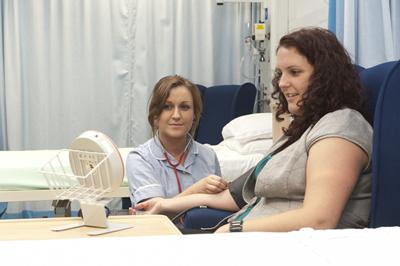Replacing professional nurses with nursing assistants linked to heightened death risk

Replacing professionally qualified nurses with lower skilled nursing assistants is linked to a heightened risk of patient death, as well as other indicators of poor quality care, reveals a large European study, published online in the journal BMJ Quality & Safety.
For every 25 patients, just one professional nurse substitution was associated with a 21 per cent rise in the odds of dying in a hospital with average nurse staffing levels and skill mix, the findings show, prompting the researchers to conclude that “diluting” the hospital nurse skill mix “is not in the public interest.”
Financial pressures, healthcare reforms, and staff shortages are forcing hospitals to look at their nursing skill mix, which varies considerably within and between countries.
In England, for example, where a new category of hospital caregiver (nursing associate) has just been introduced, the nursing skill mix varies from 79 per cent of professional nurses to 47 per cent, with an average of 57 per cent — one of the lowest in Europe.
But, say the researchers, there is very little hard evidence on the impact on patient care of diluting this mix in European hospitals; most of the data comes from the US. In a bid to rectify this, they analysed the association between nursing skill mix and the risk of patient death, patients’ views of their care, and other quality of care indicators, such as the prevalence of falls and bed sores, in acute care hospitals in Belgium, England, Finland, Ireland, Spain and Switzerland.
“This is a very timely study because the NHS in England has announced its intention to train a new category of worker called ‘nursing associates’ who have limited qualifications and to use a measure that ignores the distinctions between registered nurses and untrained assistants when comparing staffing levels between hospitals and wards,” added co-author, Peter Griffiths, Chair of Health Services Research at the University of Southampton. “England has one of the lowest percentages among European countries of professional nurses at the bedside already. Our study suggests that the NHS needs to focus on achieving safe registered nurse staffing levels as a means to achieve better outcomes including improving patients’ satisfaction with their care.”
The research drew on survey responses from just over 13,000 nurses in 243 hospitals and nearly 19,000 patients in 182 of these hospitals, as well as discharge data for more than 275,500 patients who had undergone a surgical procedure in 188 of the hospitals.

Nursing skill mix was calculated for each hospital by dividing the number of professionally qualified nurses by the number of nurse caregivers of all grades that each nurse reported as present on their unit during their last shift. These ratios were then averaged across all nurse respondents in each hospital.
Total staffing was calculated by dividing the total number of nursing staff by the number of patients each nurse reported for their unit during their last shift. These ratios were then averaged as before, and multiplied by 25 — the average number of patients in each unit.
The total nursing staff: patient ratio was 6 for every 25 patients, but ranged from around 2.5 to around 14. The average percentage of professional nurses was 66 per cent, but ranged from 41 per cent to 87 per cent.
The average hospital death rate was 12.8 for every 1000 discharges.
Around one in five nurses rated the care on their unit as poor or fair, and around a third said their hospital had a poor safety culture. Nearly a third scored high on a scale designed to detect burnout; a similar proportion were dissatisfied with their job.
And around half the patients surveyed gave their hospitals low ratings.
The final analysis showed that a higher proportion of professionally qualified nurses was associated with a significantly lower risk of death, higher levels of patient satisfaction, and fewer reported indicators of poor quality care, such as bedsores, falls, and urinary infections.
Specifically, after taking account of potentially influential factors, every 10 per cent increase in the proportion of professionally qualified nurses was associated with an 11 per cent fall in the odds of a patient dying after surgery, a 10 per cent fall in the odds of patient dissatisfaction, and an 11 per cent fall in the odds of reporting poor quality care.
And in a hospital with average nurse staffing levels and skill mix, substituting just professionally qualified nurse with one nursing assistant for every 25 patients was associated with a 21 per cent increase in the odds of dying.
Additionally, in hospitals with a higher proportion of professionally qualified nurses, these nurses were less likely to experience burnout or to be dissatisfied with their jobs.
This is an observational study, so no firm conclusions can be drawn about cause and effect, the researchers caution, added to which the study offers a snapshot of activity at a single point in time only.
Nevertheless, they write: “Findings from this large and unique study of nursing skill mix in European hospitals suggest that caution should be taken in implementing policies to reduce hospital nursing skill mix because the consequences can be life threatening for patients.”
And they conclude: “Our study adds new and important evidence that diluting hospital nurse skill mix by adding lower skilled nurse assistants and/or reducing professional nurses is not in the public interest."